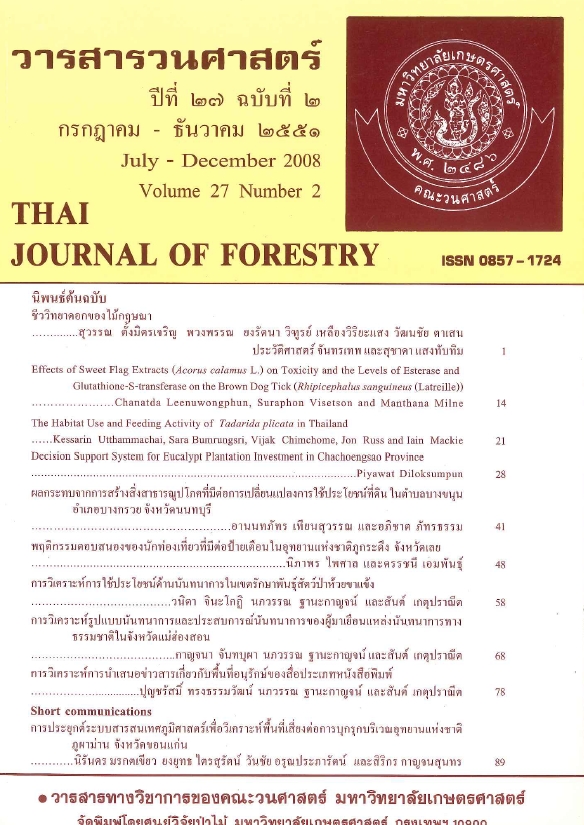The Habitat Use and Feeding Activity of Tadarida plicata in Thailand
Main Article Content
บทคัดย่อ
The study quantified feeding rate and habitat use of Tadarida plicata demonstrated the important role they play in the natural and cultivated ecosystems. This study determined habitat use and feeding activity of T. plicata in an agricultural landscape including seasonal variation in habitat use and foraging activity. The proportion of signal-receiving time over the total recording time was measured to obtain an estimate of the relative activity of bats within each habitat. It was found that bats selected villages and dry rice fields. This is probably because these habitats supported higher insect densities. In addition, it was used the number of feeding buzzes per unit of activity time to calculate an index of attack rate by bats. Bat activities at each site were estimated by calculating the average number of bats passes per minute. Analysis of Variance was conducted to examine differences in mean attack attempt (numbers of feeding buzzes per unit of activity time) between recording sessions, among habitats and seasons.
Keywords: Tadarida plicata, Habitat use, Feeding activity, Seasonal variation
Downloads
Article Details

อนุญาตภายใต้เงื่อนไข Creative Commons Attribution-NonCommercial-NoDerivatives 4.0 International License.
ข้าพเจ้าและผู้เขียนร่วม (ถ้ามี) ขอรับรองว่า ต้นฉบับที่เสนอมานี้ยังไม่เคยได้รับการตีพิมพ์และไม่ได้อยู่ในระหว่างกระบวนการพิจารณาตีพิมพ์ลงในวารสารหรือสิ่งตีพิมพ์อื่นใด ข้าพเจ้าและผู้เขียนร่วม (ถ้ามี) ยอมรับหลักเกณฑ์และเงื่อนไขการพิจารณาต้นฉบับ ทั้งยินยอมให้กองบรรณาธิการมีสิทธิ์พิจารณาและตรวจแก้ต้นฉบับได้ตามที่เห็นสมควร พร้อมนี้ขอมอบลิขสิทธิ์ผลงานที่ได้รับการตีพิมพ์ให้แก่วารสารวนศาสตร์ คณะวนศาสตร์ มหาวิทยาลัยเกษตรศาสตร์ กรณีมีการฟ้องร้องเรื่องการละเมิดลิขสิทธิ์เกี่ยวกับภาพ กราฟ ข้อความส่วนใดส่วนหนึ่ง หรือ ข้อคิดเห็นที่ปรากฏในผลงาน ให้เป็นความรับผิดชอบของข้าพเจ้าและผู้เขียนร่วม (ถ้ามี) แต่เพียงฝ่ายเดียว และหากข้าพเจ้าและผู้เขียนร่วม (ถ้ามี) ประสงค์ถอนบทความในระหว่างกระบวนการพิจารณาของทางวารสาร ข้าพเจ้าและผู้เขียนร่วม (ถ้ามี) ยินดีรับผิดชอบค่าใช้จ่ายทั้งหมดที่เกิดขึ้นในกระบวนการพิจารณาบทความนั้น”


